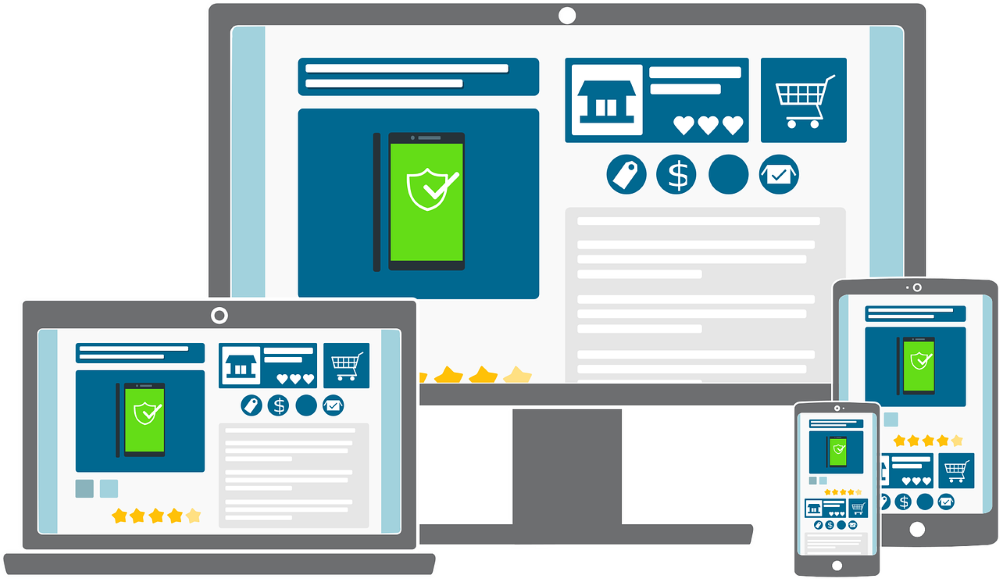
Building an ecommerce website is essential for any business looking to sell products or services online. It allows you to reach a wider audience and provides a convenient way for customers to purchase items without leaving their homes.
With the right tools and a few steps, you can create an online store that’s tailored to your products, services, and customers with minimal fuss
In this article, we will discuss the requirements for building an ecommerce website, the different types of ecommerce websites, the best way to make an ecommerce website, how long it takes to build one, and an ecommerce website design checklist.
Ecommerce website requirements
Before building an ecommerce website, it’s essential to have a clear understanding of the necessary requirements. These include:
- Domain name: A domain name is the web address where your website will be located. Choose a domain name that is easy to remember and represents your brand.
- Web hosting: Web hosting is necessary to store your website files and make them accessible on the internet.
- SSL certificate: An SSL certificate is required to ensure that all data and transactions between your website and customers are encrypted and secure.
- Payment gateway: A payment gateway allows customers to make secure online payments for the products or services they purchase on your website.
- Shopping cart: A shopping cart is necessary for customers to add items to their cart and proceed to checkout.
Types of ecommerce websites
There are several types of ecommerce websites, including:
- Business-to-consumer (B2C): B2C ecommerce websites sell products or services directly to customers.
- Business-to-business (B2B): B2B ecommerce websites sell products or services to other businesses.
- Consumer-to-consumer (C2C): C2C ecommerce websites facilitate transactions between individual customers.
Ecommerce website design checklist
When designing an ecommerce website, it’s essential to consider the following checklist:
- Simple and intuitive navigation: Make sure your website is easy to navigate and find products.
- Mobile responsiveness: Ensure your website is mobile-friendly and adapts to different screen sizes.
- High-quality product images: Use high-quality product images to showcase your products and improve the customer experience.
- Fast loading speed: A fast-loading website improves the customer experience and helps with search engine optimisation.
- Clear calls-to-action: Use clear calls-to-action to guide customers towards making a purchase.
- Trust signals: Display trust signals, such as customer reviews and trust badges, to increase trust and credibility.

How to build an ecommerce website from scratch – step-by-step guide
Plan your website’s structure
The first step in designing your ecommerce website is to plan its structure. This includes choosing a domain name that’s relevant to your business, figuring out what type of content you want on the site and where it will be placed, and selecting a website theme that fits the look and feel you want.
It’s also important to make sure your hosting plan meets all the requirements for running an ecommerce website.
While it’s tempting to just dive in and start building your ecommerce website, this can lead to a lot of frustration.
Taking the time to plan out the structure of your site before you start building will save you a lot of time in the end. You should decide how many pages you need, what kind of content each page will have, which features are necessary for running an ecommerce store, and consider any additional features that might make the user experience more enjoyable.
Also, make sure you choose a domain name that’s easy to remember, but still represents your business. Spending some extra time developing a good plan now can mean a smoother launch process later on.
Find ecommerce software that fits your needs
To create an ecommerce website, you’ll need software that will manage the online store.
Popular ecommerce platforms such as Shopify and WooCommerce come with all the features and tools needed to help you get started, including shopping cart and checkout options, built-in payment processors, hundreds of customisable themes, support for multiple languages and currencies, as well as a wide selection of plugins and add-ons.
Knowing what each platform offers can help you determine which one is best suited to your needs.
Once you’ve chosen your ecommerce platform, the next step is to design your website. This can be done with ease using one of the customisable themes provided by the ecommerce software or by using a drag-and-drop website builder.
No matter what method you choose, be sure to make sure that the design of your site reflects the products, services and brand you are promoting. You will also want to consider plugins and add-ons that can further enhance your site’s features such as cyber security, SEO optimisation, analytics tracking, and more.
Design and develop the website architecture
Before jumping in and building your ecommerce website, you’ll need to consider the architecture of your website — from the shopping cart to the checkout process. Consider what features and functionality your customers will need, such as product search and filter options, as well as ways to optimise page loading time and conversion rate.
Also think about how you can use product bundles, discounts and loyalty programs to increase profitability. Once the architecture is determined, the next step is developing the site with a platform that best matches these functionalities.
To get started building a simple ecommerce website, find a platform like Shopify or WooCommerce. These platforms provide you with easy-to-use tools to build the entire online storefront.
Drag and drop elements, customise your store’s design, browse plugins to add new features — each step provides a fast and simple way to bring the ecommerce site idea to life.
As you explore platforms and customise the website, make sure it is mobile-friendly to reach more potential customers who are shopping from their phones. Once your ecommerce site is finished, you can start listing products and marketing your business.
Set up payment processing platforms for customers to make payments
Most ecommerce stores use a payment processor, to securely accept transactions and payments from customers.
There are several popular payment processing platforms to choose from, including PayPal, Stripe, or Square. You can also look into options from major banks like Westpac, Commonwealth Bank or NAB.
Whichever platform you decide to use for processing payments for your ecommerce website, make sure you research their fees, security protocols, and customer support offerings before selecting one.
Before you can begin setting up your payment processor, you first need to sign up for an account with the platform. The process and requirements may vary, but typically you will need to provide some personal information such as your name, address, and business information to create an account.
Once you have an account set up, you must link it to a bank account or credit card to accept payments from customers. You may also need to configure security measures like two-factor authentication or secure encryption technology to properly protect your customers’ payment information.
After setting up a payment processor for your ecommerce website, make sure that it integrates seamlessly with your sales page and checkout page.

Add necessary shipping, tax, and pricing calculators to your store
Most online stores require shipping calculators, to account for the accurate delivery of products to customers based on their location. Additionally, you will need tax calculators to ensure that you charge customers the correct levels of taxes for each item sold.
Price calculators are also essential for any ecommerce store, as they set the baseline for how much customers should be charged for items based on various factors like discounts and promotions.
To begin setting up these calculators, you will first need to identify which ones are necessary for your store. For each calculator that you set up, you will also need to create a database of associated variables, such as customer locations and various shipping speeds, as well as discounts and taxes associated with each item online.
Such databases should be carefully monitored and updated periodically as needed to ensure accuracy when calculating charges for customers’ purchases.
Some ecommerce platforms already include calculators for prices, taxes, and shipping in their integrations—so do make sure to check if anything is compatible with your store before building from scratch.
Best way to make an ecommerce website
The best way to make an ecommerce website is to use an ecommerce platform. Some popular ecommerce platforms include:
- Shopify: Shopify is a popular ecommerce platform that offers a wide range of features and tools to help you build and manage your online store.
- WooCommerce: WooCommerce is a free ecommerce plugin for WordPress that allows you to turn your WordPress website into an online store.
- Magento: Magento is a powerful ecommerce platform that is suitable for large and complex online stores.
- BigCommerce: BigCommerce is a powerful ecommerce platform that is suitable for large and complex online stores. It offers advanced features, including multichannel selling, advanced SEO tools, and a wide range of integrations.
When deciding which platform to use for building an ecommerce website, it’s important to consider your business needs and technical expertise.
Shopify is a popular all-in-one ecommerce platform that’s easy to use and doesn’t require technical expertise. It’s a great option for businesses that want a simple setup process and pre-designed templates, as well as built-in features like payment processing, shipping, and inventory management. Shopify also offers a range of apps and plugins to help you customise your online store and add advanced features.
WooCommerce is an ecommerce plugin for WordPress that’s ideal for businesses that want a flexible and customisable platform. It offers a range of customisation options and plugins, making it a great choice for businesses that want to add advanced features like membership programs or subscription boxes. However, WooCommerce requires a higher level of technical expertise to set up and manage than some other platforms.
Magento is a more complex platform that’s ideal for large ecommerce websites with complex product catalogues and advanced features, but it requires a higher level of technical expertise to manage.
BigCommerce is a cloud-based ecommerce platform that’s ideal for businesses that want a scalable and customisable platform with advanced features. It offers a range of built-in features like payment processing, shipping, and inventory management, as well as customisation options and integrations. BigCommerce is a great option for businesses that expect to grow their online store in the future and need a platform that can keep up with their needs.
Other tools that can be used for building an ecommerce website
- WordPress: WordPress is a popular content management system that can be used to create an ecommerce website. It is user-friendly and easy to use and has a large community of developers who create plugins and themes for ecommerce websites.
- HTML and CSS: HTML and CSS are the building blocks of web development. HTML is used to create the structure of a webpage, while CSS is used to style it. These languages are essential for building an ecommerce website from scratch.
- Angular: Angular is a JavaScript framework that can be used to build dynamic web applications, including ecommerce websites. It is known for its flexibility and scalability and is used by many large ecommerce websites.
- PHP: PHP is a server-side scripting language that is widely used for web development. It can be used to create ecommerce websites and is compatible with many content management systems and ecommerce platforms.
- Python: Python is a high-level programming language that is popular for web development. It can be used to build ecommerce websites, particularly those that require complex functionality such as machine learning or AI.
- Bootstrap: Bootstrap is a popular CSS framework that can be used to create responsive and mobile-friendly ecommerce websites. It provides a range of pre-designed components that can be used to speed up the development process.
- React: React is a JavaScript library that can be used to build dynamic user interfaces for web applications, including ecommerce websites. It is known for its speed and flexibility and is used by many large ecommerce websites.
In conclusion, the best tool for building an ecommerce website depends on your specific needs and preferences.
WordPress is a popular ecommerce platform that is easy to use and can handle large ecommerce websites. Angular, React, and JavaScript are ideal for building dynamic web applications, while Python is well-suited for building ecommerce websites that require complex functionality. HTML and CSS are essential for building an ecommerce website from scratch, while Bootstrap provides pre-designed components to speed up the development process.
Ultimately, the choice of tool will depend on the specific needs and goals of your ecommerce website.

Ecommerce website design best practices
When designing an ecommerce website, it’s important to follow best practices to ensure that your website is user-friendly and drives sales. Some ecommerce website design best practices include:
- Keep it simple: A simple and clean design makes it easier for customers to find what they’re looking for and reduces distractions.
- Prioritise mobile design: With more people shopping on their mobile devices, it’s important to ensure that your website is mobile-friendly and responsive.
- Use high-quality product images: High-quality images help showcase your products and improve the customer experience.
- Provide clear calls-to-action: Use clear and concise calls-to-action to guide customers towards making a purchase.
- Make checkout easy: Simplify the checkout process as much as possible to reduce cart abandonment rates.
Ecommerce website design trends
Ecommerce website design trends are constantly evolving. Some current ecommerce website design trends include:
- Dark mode: Dark mode is becoming increasingly popular and can help reduce eye strain and improve the user experience.
- Minimalism: A minimalistic design with plenty of white space can make your website look clean and modern.
- Custom illustrations: Custom illustrations can add personality to your website and make it stand out.
- 3D product visuals: 3D product visuals allow customers to view products from all angles, which can help improve the customer experience.
Ecommerce website design templates
Using an ecommerce website design template can help you get started quickly and easily. Some popular ecommerce website design templates include:
- Divi: Divi is a popular WordPress theme that includes a wide range of ecommerce design templates and features.
- Shopify themes: Shopify offers a wide range of ecommerce website design templates that can be customised to your needs.
- Squarespace templates: Squarespace offers a range of beautiful and modern ecommerce website design templates.
Easiest ecommerce website builder
When it comes to building an ecommerce website, some of the easiest ecommerce website builders include:
- Shopify: Shopify is one of the easiest ecommerce website builders to use. It offers a user-friendly interface and a wide range of features and tools to help you create and manage your online store.
- Wix: Wix is a drag-and-drop website builder that offers a range of ecommerce features and templates.
- Weebly: Weebly is a user-friendly website builder that includes a range of ecommerce features and tools.

Frequently asked questions
Do I need to have the technical knowledge to build an ecommerce website?
It depends on the tools and platforms you use. Some website builders and platforms are designed for beginners and require no coding or technical knowledge, while others may require some technical expertise.
How much does it cost to build an ecommerce website?
The cost of building an ecommerce website can vary widely depending on factors such as the size and complexity of the website, the tools and platforms used, and whether you hire a professional developer or use a website builder. On average, you can expect to pay between $4,000 and $10,000 for a basic ecommerce website.
How long does it take to build an ecommerce website?
The time it takes to build an ecommerce website can vary depending on the complexity of the website and the tools and platforms used. On average, it can take anywhere from a few days to several months to build an ecommerce website.
Are website design costs tax deductible in Australia?
Yes, website design costs are generally tax deductible in Australia if they are incurred in the course of running a business. However, it’s important to consult with a tax professional or accountant to determine the specific tax implications for your business.
Can I build an ecommerce website myself or should I hire a professional?
It depends on your technical knowledge and the complexity of the website you want to build. If you have some technical expertise and are comfortable using website builders or content management systems, you may be able to build an ecommerce website yourself.
However, if you need a more complex website or don’t have the technical skills, you may want to consider hiring a professional developer or agency.
How can I ensure my ecommerce website is secure?
There are several steps you can take to ensure your ecommerce website is secure, such as using a secure web hosting service, installing an SSL certificate, using strong passwords, and implementing two-factor authentication. It’s also important to regularly update your website software and plugins to ensure they are secure and up-to-date.
What payment methods should I offer on my ecommerce website?
It’s important to offer a range of payment methods on your ecommerce website to cater to different customer preferences. Popular payment methods include credit cards, PayPal, Apple Pay, Google Pay, and Afterpay. It’s also important to ensure that your payment gateway is secure and reliable.
How can I drive traffic to my ecommerce website?
There are several strategies you can use to drive traffic to your ecommerce website, such as search engine optimisation (SEO), social media marketing, email marketing, content marketing, and paid advertising. It’s important to develop a comprehensive marketing strategy that targets your ideal customers and drives traffic to your website.
Building an ecommerce website with DesignQ
DesignQ is a professional web design and development agency based in Australia. If you’re looking to build a custom ecommerce website that’s tailored to your unique business needs, DesignQ can help.
Here are a few ways to get started:
- Schedule a consultation: If you’re not sure where to start or have questions about the web design and development process, schedule a consultation with the DesignQ team. We can walk you through the process, answer any questions you have, and provide a custom quote based on your specific needs.
- Check out our portfolio: Want to see examples of the custom ecommerce websites DesignQ has built for other businesses? Check out our portfolio to see some of our past work and get inspired.
- Request a quote: If you’re ready to get started building your custom ecommerce website, request a quote from DesignQ. We’ll work with you to determine your needs and provide a custom quote for your project.
At DesignQ, our goal is to build beautiful, functional, and effective websites that help businesses succeed online. Contact us today to learn how we can help your business grow.
Conclusion
Building an ecommerce website can be a complex and challenging process, but with the right tools, platforms, and expertise, it’s possible to create a beautiful and functional online store that meets your business needs.
Whether you’re looking to build a simple ecommerce website or a more complex online store with custom features and integrations, there are a variety of tools and platforms available to help you achieve your goals.
When choosing a platform or tool for your ecommerce website, it’s important to consider factors such as your technical expertise, budget, and the specific features and integrations you need. Platforms like WordPress, Magento, and Shopify offer a range of features and integrations to help you build a custom ecommerce website, while website builders like Wix and Squarespace provide an easy-to-use interface for beginners.
Ultimately, the best way to build a custom ecommerce website that meets your business needs is to work with a professional web design and development agency like DesignQ.
We have the expertise and experience to create a beautiful and functional online store that’s tailored to your unique business needs. With our help, you can build an ecommerce website that drives sales, engages customers, and helps your business thrive online.










